The dominant role of many-body correlations in TMDs superconductivity
Several classes of correlated electron systems such as cuprates, iron-pnictides, iron-chalcogenides, and several heavy-fermion compounds, have been identified as unconventional superconductors. More recently, superconductivity with unconventional features has also been identified in twisted bilayer graphene. In this vein, the electronic correlations intrinsically present in transition metal dichalcogenides (TMDs), a family of layered materials, are promising candidates to provide an alternative route to unconventional superconductivity.
In general, the different experimental complexities to produce and probe these materials make the study of their unconventional superconductivity a formidable problem. But, in the case of TMDs, we find that they can be easily obtained by several methods (molecular beam epitaxy, carbon vapor deposition, atomic layer deposition, exfoliation, etc.), to yield scalable 2D superconductors of simple handling and transfer. For this very reason, understanding superconductivity in these materials would open a path towards unconventional superconductivity in simple, scalable and transferable 2D superconductors.
Now, a team of researchers reports 1 the observation of superconducting collective modes in single-layer NbSe2.

Among 2D TMD superconductors, single-layer NbSe2 has received the most attention and its superconducting properties have been extensively studied. Monolayer NbSe2 has a non-centrosymmetric crystal structure (point group D3h) which enables a form of spin orbit coupling where spins lock out of the plane, leading to Ising superconductivity with enhanced robustness to in-plane magnetic fields. NbSe2 is a superconductor with a critical temperature of 7.2 K.
More recently, transport experiments have revealed a two-fold anisotropy of the superconducting state under in-plane magnetic fields, which has been interpreted in terms of a competing nematic superconducting instability. In parallel, experiments suggest sizable electronic correlations as the origin of the competing pairing instabilities.
In this new work, the team investigated the superconducting properties of single-layer NbSe2 with samples grown by molecular beam epitaxy on bilayer graphene on SiC(0001) and h-BN/Ir(111) substrates. By means of high-resolution scanning tunneling microscopy and spectroscopy (STM/STS) measurements at 340 mK, the researchers observed a collective mode univocally associated to superconductivity, which they attribute to a related competing triplet (f-wave) pairing channel. This finding strongly suggests that many-body correlations play a dominant role in the emergence of superconductivity among TMD superconductors.
These results create exciting new opportunities for directly exploring unconventional superconductivity in a 2D material of simple synthesis, handling, and experimental analysis.
Author: César Tomé López is a science writer and the editor of Mapping Ignorance
Disclaimer: Parts of this article may be copied verbatim or almost verbatim from the referenced research papers.
References
- Wan, W., Dreher, P., Muñoz-Segovia, D., Harsh, R., Guo, H., Martínez-Galera, A.J., Guinea, F., de Juan, F. and Ugeda, M.M. (2022), Observation of Superconducting Collective Modes from Competing Pairing Instabilities in Single-layer NbSe2. Advanced Materials doi: 10.1002/adma.202206078 ↩